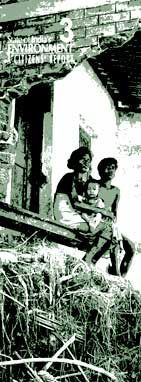 "Rich and poor, both
cause environmental destruction but it is the poor who are affected most by it. The
field experience of voluntary groups shows clearly that eradication of poverty in a
country like India is simply not possible without the rational management of our
environment and that conversely environmental destruction will only intensity poverty
— a fact seldom recognised." "Rich and poor, both
cause environmental destruction but it is the poor who are affected most by it. The
field experience of voluntary groups shows clearly that eradication of poverty in a
country like India is simply not possible without the rational management of our
environment and that conversely environmental destruction will only intensity poverty
— a fact seldom recognised."
The Fifth World Conservation Lecture:
WWF-UK, London, October 8, 1985
  
"The environment is not just pretty trees
and tigers… threatened plants and ecosystems. It is literally the entity on which we
all subsist, and on which entire agricultural and industrial development depends."
State of India’s Environment
— The Second Citizens’ Report, CSE, 1985
  
"The Third World’s population crisis
today arises not because its current growth is unprecedented, but because it can neither
solve its problem by spilling over into other ecosystems (like the Europeans) nor does it
have the financial clout to purchase resources from other ecosystems. The Third
World can survive only by finding a process of development that would allow it to
accommodate its people by developing resources available within its own ecosystems. This
is something the western development model does not know and cannot teach."
State of India’s Environment
— The Second Citizens’ Report, CSE, 1985
  
"Embankments, and politicians, aggravate
floods. This report takes on a big myth: that floods in the plans are caused by
deforestation in the Himalayas. The Himalaya is the youngest mountain chain in the world,
prove to erosion. The Himalaya erodes at the rate of I mm, but rises 7 mm, annually. They
are lashed by rainstorms and are seismic. Water and silt move out of these mountains in
explosive waves. Floods and shifting of river courses is, therefore, inevitable.
Deforestation can aggravate the problem but afforestation cannot get rid of it.
Embankments and dams have become an implement case of floods. We need better flood plain
management, rather than flood control."
State of India’s Environment
— The Third Citizens’ Report, CSE, 1987
  
 "It amounts to environmental colonialism.
The methane issue raises further questions of justice and morality. Can we really
equate the CO2 contributions of gas guzzling automobiles in Europe and North
America or, for that matter anywhere in the Third World with the methane emissions of
drought cattle and rice fields of subsistence farmers in West Bengal or Thailand?" "It amounts to environmental colonialism.
The methane issue raises further questions of justice and morality. Can we really
equate the CO2 contributions of gas guzzling automobiles in Europe and North
America or, for that matter anywhere in the Third World with the methane emissions of
drought cattle and rice fields of subsistence farmers in West Bengal or Thailand?"
Global warming in an unequal world,
CSE, 1991
  
"Why this magazine? This magazine
is not the product of a desire to capture a share of the information market. It is the
product of a need that we feel within us, a desire to till a critical information gap. In
the years ahead, India will have to seize every possible opportunity to grow and develop
and at the same time it will have to make a bold effort to hold on to its soil and roots.
This task is not going to be easy.
We will bring reports from our farms, fields, forests,
factories and laboratories… we intend to report all those things that a regular
magazine or newspaper will report — but we will look at all this with two eyes, the
eyes of science and of environment."
Down To Earth, May 31, 1992
  
|